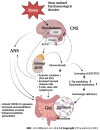Molecular signalling during cross talk between gut brain axis regulation and progression of irritable bowel syndrome: A comprehensive review
- PMID: 37469740
- PMCID: PMC10353503
- DOI: 10.12998/wjcc.v11.i19.4458
Molecular signalling during cross talk between gut brain axis regulation and progression of irritable bowel syndrome: A comprehensive review
Abstract
Irritable bowel syndrome (IBS) is a chronic functional disorder which alters gastrointestinal (GI) functions, thus leading to compromised health status. Pathophysiology of IBS is not fully understood, whereas abnormal gut brain axis (GBA) has been identified as a major etiological factor. Recent studies are suggestive for visceral hyper-sensitivity, altered gut motility and dysfunctional autonomous nervous system as the main clinical abnormalities in IBS patients. Bidirectional signalling interactions among these abnormalities are derived through various exogenous and endogenous factors, such as microbiota population and diversity, microbial metabolites, dietary uptake, and psychological abnormalities. Strategic efforts focused to study these interactions including probiotics, antibiotics and fecal transplantations in normal and germ-free animals are clearly suggestive for the pivotal role of gut microbiota in IBS etiology. Additionally, neurotransmitters act as communication tools between enteric microbiota and brain functions, where serotonin (5-hydroxytryptamine) plays a key role in pathophysiology of IBS. It regulates GI motility, pain sense and inflammatory responses particular to mucosal and brain activity. In the absence of a better understanding of various interconnected crosstalks in GBA, more scientific efforts are required in the search of novel and targeted therapies for the management of IBS. In this review, we have summarized the gut microbial composition, interconnected signalling pathways and their regulators, available therapeutics, and the gaps needed to fill for a better management of IBS.
Keywords: Gut brain axis; Irritable bowel syndrome; Microbiota; Serotonin; Stress.
©The Author(s) 2023. Published by Baishideng Publishing Group Inc. All rights reserved.
Conflict of interest statement
Conflict-of-interest statement: All the authors report no relevant conflicts of interest for this article.
Figures




Similar articles
-
Irritable bowel syndrome: a gut microbiota-related disorder?Am J Physiol Gastrointest Liver Physiol. 2017 Jan 1;312(1):G52-G62. doi: 10.1152/ajpgi.00338.2016. Epub 2016 Nov 23. Am J Physiol Gastrointest Liver Physiol. 2017. PMID: 27881403 Free PMC article. Review.
-
Neurotransmitter and Intestinal Interactions: Focus on the Microbiota-Gut-Brain Axis in Irritable Bowel Syndrome.Front Endocrinol (Lausanne). 2022 Feb 16;13:817100. doi: 10.3389/fendo.2022.817100. eCollection 2022. Front Endocrinol (Lausanne). 2022. PMID: 35250873 Free PMC article. Review.
-
Stress and the gut: pathophysiology, clinical consequences, diagnostic approach and treatment options.J Physiol Pharmacol. 2011 Dec;62(6):591-9. J Physiol Pharmacol. 2011. PMID: 22314561 Review.
-
Gut Microbiota-Derived Metabolites in Irritable Bowel Syndrome.Front Cell Infect Microbiol. 2021 Sep 23;11:729346. doi: 10.3389/fcimb.2021.729346. eCollection 2021. Front Cell Infect Microbiol. 2021. PMID: 34631603 Free PMC article. Review.
-
Irritable bowel syndrome, gut microbiota and probiotics.J Neurogastroenterol Motil. 2011 Jul;17(3):252-66. doi: 10.5056/jnm.2011.17.3.252. Epub 2011 Jul 13. J Neurogastroenterol Motil. 2011. PMID: 21860817 Free PMC article.
Cited by
-
Use of 16s RNA and metabolomics to investigate the therapeutic effect of Zhuyang Tongbian Decoction on mice with functional constipation.Am J Transl Res. 2025 Jan 15;17(1):87-103. doi: 10.62347/MBJY3014. eCollection 2025. Am J Transl Res. 2025. PMID: 39959240 Free PMC article.
-
Visnagin treatment attenuates DSS-induced colitis by regulating inflammation, oxidative, stress, and mucosal damage.Front Vet Sci. 2025 May 28;12:1558092. doi: 10.3389/fvets.2025.1558092. eCollection 2025. Front Vet Sci. 2025. PMID: 40502390 Free PMC article.
-
Mirtazapine for gastrointestinal and neuropsychological symptoms in older adults with irritable bowel syndrome.Therap Adv Gastroenterol. 2024 Oct 24;18:17562848241278125. doi: 10.1177/17562848241278125. eCollection 2024. Therap Adv Gastroenterol. 2024. PMID: 39493642 Free PMC article. Review.
-
Adjunct Therapies to Standard Care for IBS and IBD Patients: Digestive Symptoms Improvement and Quality of Life Optimization.Nutrients. 2024 Nov 18;16(22):3927. doi: 10.3390/nu16223927. Nutrients. 2024. PMID: 39599713 Free PMC article. Review.
-
From bugs to brain: unravelling the GABA signalling networks in the brain-gut-microbiome axis.Brain. 2025 May 13;148(5):1479-1506. doi: 10.1093/brain/awae413. Brain. 2025. PMID: 39716883 Free PMC article. Review.
References
-
- Leite G, Pimentel M, Barlow GM, Chang C, Hosseini A, Wang J, Parodi G, Sedighi R, Rezaie A, Mathur R. Age and the aging process significantly alter the small bowel microbiome. Cell Rep. 2021;36:109765. - PubMed
Publication types
LinkOut - more resources
Full Text Sources

